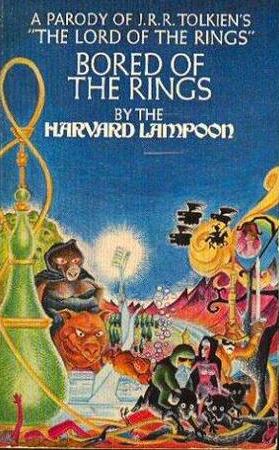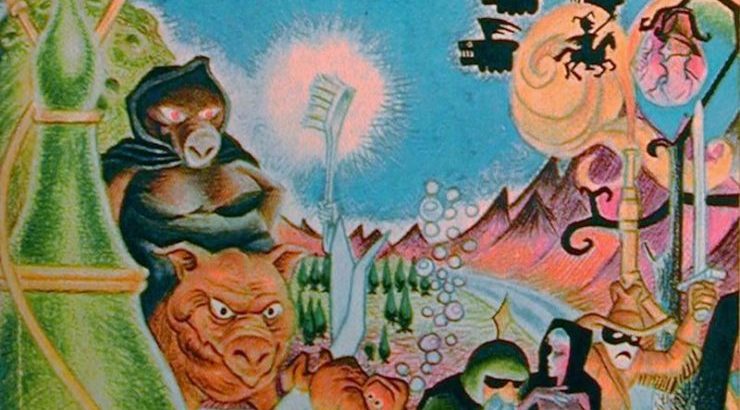In 1969 Doug Kenney and Henry Beard, editors of the prestigious comedy magazine The Harvard Lampoon (and soon-to-be creators of the National Lampoon) co-wrote a deeply silly parody of Lord of the Rings called, wait for it, Bored of the Rings. It turns out that a long, debauched scene at the book launch for Bored of the Rings features prominently in David Wain’s (somewhat fictionalized) recent biopic of Kenney, A Futile and Stupid Gesture. While I was watching the film I realized that (a) I had the book, and (b) I had somehow never read it. And thus this week’s TBR Stack is born!
I have to say, I was shocked by how many interesting comedic thoughts Kenney and Beard stuffed in under all the silliness.
Buy the Book


Bored of the Rings
As a comedy nerd I’ve been maybe a little obsessed with the Lampoon. I’ve always been interested in the fact that a group of guys with Ivy League educations were the ones who paved the way to both the mainstreamed anarchy of early SNL and the entire school of “slobs vs. snobs” comedy that defined the early ’80s. So it’s especially cool to look at this book, written while Kenney and Bear were still in school, before they had any idea that their comedy hobby would become a real career.
When I started the book I found it slow-going: they open with a salacious scene between a Boggie (read: Hobbit) and an elf maiden, and then dive right into some obvious (and cheap, imo) gags by renaming Bilbo Baggins “Dildo Bugger” before crowing about how they’ve only written the book for a quick paycheck, and then spending entirely too much time on a chapter called “Concerning Boggies” that made me want to throw the book across the room. I thought this was going to be a lonnnng 160-page paperback.
But then the comedy kicks into a different gear when they begin mashing consumerism up with high fantasy tropes. The heroes of the story are renamed for junk food: Frodo, Sam, Merry, and Pippin become Frito, Spam, Moxie, and Pepsi. Boromir becomes Bromosel; named after the antacid, Bromosel seems to be aware of the fact that he’s in a story, and breaks the fourth wall to comment on the action. Aragorn son of Arathorn, called Strider, is now Arrowroot son of Arrowshirt, called Stomper, the first in a variety of riffs on Disney. Gandalf isn’t a wizard because there’s no magic here. Instead he’s Goodgulf Greyteeth, described as a “discredited Rosicrucian,” “32nd Degree Mason,” and “Honorary Shriner,” and his great battle is with a “Ballhog” clad in a Villanova jersey. This is all silly and fun, but more telling is that the Goodgulf’s subsequent transformation is entirely cosmetic, centering on gleaming white bellbottoms, a Nehru jacket, and a far out medallion, rather than any spiritual growth.
The riders of Rohan become Riders of Roi-Tan, who are pretty clearly, um, Nazis, written in the same over-the-top parody style that Mel Brooks and Carl Reiner used to mock unspeakable horror, with drinking songs:
Ve dance und sing und valse und two-step
Und never ever mach der goose-step
Peace is vhat ve vhant und do have
Und a piece of anything you have
There’s a slightly sharper stab when the Roi-Tanners side-eye Gimlet, son of Groin, because he looks so…Dwarfish—a nice nod to the charge that Tolkien’s Dwarves were too close to anti-Semitic stereotypes. This more pointed satire jostles against the Narcs of Fordor, cast as a black leather-clad motorcycle gang, Tim Benzedrine and his old lady Hashberry, and Birds-Eye of the Vee-Ates, a Jolly Green Giant/Treebeard mashup who speaks entirely in produce puns. Again, silly. But Bored of the Rings does have a slightly more interesting current running through it: like Lolita, it took an easy, marketable hook, and used it to create a cutting satire of shallow consumerism and the good-old-fashioned American road trip.
BOTR was published in 1969. The American highway system was first codified by various ‘auto trail associations,’ which banded together to number the country’s highways by the mid-1920s. The Interstate system was formed in the mid-1950s as part of a gigantic public works program helmed by Eisenhower, in an effort to bolster a national defense system. But much like the internet, a program originally intended for military use was soon overrun by American civilians in search of escapism, and by 1960 the romantic ideal of a cross country drive had been cemented in the US collective consciousness. Whether it was a wholesome family traveling together and reading Brylcreem ads aloud, a lone searcher as in On the Road or Travels with Charley, or the weekly woobies of the Route 66 television series, the idea of getting various types of kicks on the American open road was irresistible, and ripe for parody.
BOTR takes the fellowship not to the Prancing Pony, but to a Howard Johnson Motor Lodge, already retro and nostalgic by 1969. They head to an “orange-and-green flashing sign” and find:
…a gaudy plexiglas and chrome inn, whose blinking sign portrayed a boar, rampant, devoured by a mouth, drooling. Beneath it was the names of the inn, the Goode Eats & Lodging. Passing through the revolving door, the party signaled the bell clerk, whose name tag read Hi! I’m Hojo Hominigritts!. Like the rest of the staff, he was costumed as a suckling pig with false sow’s ears, tail, and papier-maché snout.
It takes them into Riv’n’dell, the Last Homely House East of the Sea and Gift Shoppe (Barca-Loungers in every room!), and then into Lornadoon. Where Rivendell is recast as a gingerbread village, Lothlorien is a high-fantasy Knott’s Berry Farm or South of the Border, like any number of little roadside attractions that gradually outgrew their humble origins to become destinations in their own right.
On the far bank of the river they found a thick strand of dead trees covered with signs in Elveranto which said, “Come to fabulous Elf Village,” “Visit the Snake Farm,” “Don’t miss Santa’s Workshop,” and “Help Keep Our Forest Enchanted!”
“Lalornadoon, Lalornadoon,” sighed Legolam, “wonder of Lower Middle Earth!”
At that a small door in the trunk of a large tree opened, revealing a small room filled with postcard racks, loudly clicking cuckoo clocks, and boxes of maple-sugar candies. A greasy-looking elf slipped out from behind a taffy machine.
But it’s when we get to Saruman (renamed Serutan, after a laxative) that the claws really come out:
Down in the low valley lay the pastel pink-and-blue walls of Serutan’s mighty fortress. The entire city was ringed with walls, and around the walls was a pale-lavender moat crossed by a bright-green drawbridge… Beyond the walls the expedition saw the many wonders that had lured countless tourists through its portals in the past.
Amusements of all description lay within: carnivals and sideshows under permanent tents, fairies’ wheels and gollum-coasters, tunnels of troth, griffin-go-rounds and gaming houses where a yokel could lose an idle hour, and, if he wasn’t careful, his jerkin… Everywhere, they noticed, were the brainless grins of Dickey Dragon. Pennants, signs, walls all bore that same idiotic, tongue-lolling face, But now that once-beloved creature had revealed itself to be the symbol of its creator’s lust for power, a power that had to be ended.
And imagine my astonishment when this reliance on road trip cliches settled a longstanding debate in Tolkien fandom! Because now when Frito and Spam are rescued by an eagle (in this case Gwahno, The Windlord) it actually ties the book together perfectly. Gwahno is efficient to the point of rudeness, yelling at them to fasten their seatbelts, snapping at them to use the barf bags if necessary, and complaining about running behind schedule: he’s the encapsulation of everything wrong with air travel. After all their picaresque adventures in Americana and kitsch, they end firmly in the angry, efficiency-at-all-costs Jet Age. And thus this ridiculous parody becomes a commentary on the perils of modernism, just like Lord of the Rings itself.
Fair warning that much of the humor is dated (and there’s a Br’er Rabbit rewrite that’s not so much dated as racist) but there’s also some fun satire, and a genuine sense of affection for the source material that makes the whole enterprise worth the read.
Leah Schnelbach knows that as soon as this TBR Stack is defeated, another will rise in its place. Come give her reading suggestions on Twitter!










